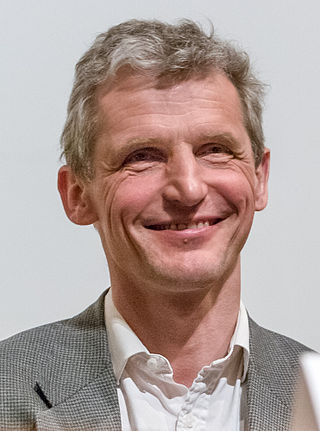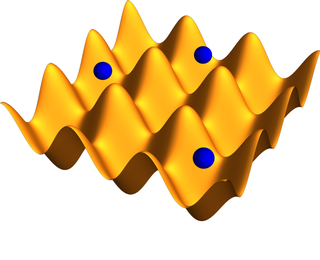Related Research Articles

In condensed matter physics, a Bose–Einstein condensate (BEC) is a state of matter that is typically formed when a gas of bosons at very low densities is cooled to temperatures very close to absolute zero. Under such conditions, a large fraction of bosons occupy the lowest quantum state, at which microscopic quantum-mechanical phenomena, particularly wavefunction interference, become apparent macroscopically. More generally, condensation refers to the appearance of macroscopic occupation of one or several states: for example, in BCS theory, a superconductor is a condensate of Cooper pairs. As such, condensation can be associated with phase transition, and the macroscopic occupation of the state is the order parameter.

In condensed matter physics, a supersolid is a spatially ordered material with superfluid properties. In the case of helium-4, it has been conjectured since the 1960s that it might be possible to create a supersolid. Starting from 2017, a definitive proof for the existence of this state was provided by several experiments using atomic Bose–Einstein condensates. The general conditions required for supersolidity to emerge in a certain substance are a topic of ongoing research.

Deborah Shiu-lan Jin was an American physicist and fellow with the National Institute of Standards and Technology (NIST); Professor Adjunct, Department of Physics at the University of Colorado; and a fellow of the JILA, a NIST joint laboratory with the University of Colorado.
In physics, a Tonks–Girardeau gas is a Bose gas in which the repulsive interactions between bosonic particles confined to one dimension dominate the system's physics. It is named after physicists Marvin D. Girardeau and Lewi Tonks. It is not a Bose–Einstein condensate as it does not demonstrate any of the necessary characteristics, such as off-diagonal long-range order or a unitary two-body correlation function, even in a thermodynamic limit and as such cannot be described by a macroscopically occupied orbital in the Gross–Pitaevskii formulation.

Wolfgang Ketterle is a German physicist and professor of physics at the Massachusetts Institute of Technology (MIT). His research has focused on experiments that trap and cool atoms to temperatures close to absolute zero, and he led one of the first groups to realize Bose–Einstein condensation in these systems in 1995. For this achievement, as well as early fundamental studies of condensates, he was awarded the Nobel Prize in Physics in 2001, together with Eric Allin Cornell and Carl Wieman.

Lene Vestergaard Hau is a Danish physicist and educator. She is the Mallinckrodt Professor of Physics and of Applied Physics at Harvard University.

Rudolf Grimm is an experimental physicist from Austria. His work centres on ultracold atoms and quantum gases. He was the first scientist worldwide who, with his team, succeeded in realizing a Bose–Einstein condensation of molecules.

An optical lattice is formed by the interference of counter-propagating laser beams, creating a spatially periodic polarization pattern. The resulting periodic potential may trap neutral atoms via the Stark shift. Atoms are cooled and congregate at the potential extrema. The resulting arrangement of trapped atoms resembles a crystal lattice and can be used for quantum simulation.
In condensed matter physics, an ultracold atom is an atom with a temperature near absolute zero. At such temperatures, an atom's quantum-mechanical properties become important.
A sonic black hole, sometimes called a dumb hole or acoustic black hole, is a phenomenon in which phonons are unable to escape from a region of a fluid that is flowing more quickly than the local speed of sound. They are called sonic, or acoustic, black holes because these trapped phonons are analogous to light in astrophysical (gravitational) black holes. Physicists are interested in them because they have many properties similar to astrophysical black holes and, in particular, emit a phononic version of Hawking radiation. This Hawking radiation can be spontaneously created by quantum vacuum fluctuations, in close analogy with Hawking radiation from a real black hole. On the other hand, the Hawking radiation can be stimulated in a classical process. The boundary of a sonic black hole, at which the flow speed changes from being greater than the speed of sound to less than the speed of sound, is called the event horizon.
Atomtronics is an emerging type of computing consisting of matter-wave circuits which coherently guide propagating ultra-cold atoms. The systems typically include components analogous to those found in electronic or optical systems, such as beam splitters and transistors. Applications range from studies of fundamental physics to the development of practical devices.
Superstripes is a generic name for a phase with spatial broken symmetry that favors the onset of superconducting or superfluid quantum order. This scenario emerged in the 1990s when non-homogeneous metallic heterostructures at the atomic limit with a broken spatial symmetry have been found to favor superconductivity. Before a broken spatial symmetry was expected to compete and suppress the superconducting order. The driving mechanism for the amplification of the superconductivity critical temperature in superstripes matter has been proposed to be the shape resonance in the energy gap parameters ∆n that is a type of Fano resonance for coexisting condensates.

Superfluidity is the characteristic property of a fluid with zero viscosity which therefore flows without any loss of kinetic energy. When stirred, a superfluid forms vortices that continue to rotate indefinitely. Superfluidity occurs in two isotopes of helium when they are liquefied by cooling to cryogenic temperatures. It is also a property of various other exotic states of matter theorized to exist in astrophysics, high-energy physics, and theories of quantum gravity. The theory of superfluidity was developed by Soviet theoretical physicists Lev Landau and Isaak Khalatnikov.
Immanuel Bloch is a German experimental physicist. His research is focused on the investigation of quantum many-body systems using ultracold atomic and molecular quantum gases. Bloch is known for his work on atoms in artificial crystals of light, optical lattices, especially the first realization of a quantum phase transition from a weakly interacting superfluid to a strongly interacting Mott insulating state of matter.

Tilman Esslinger is a German experimental physicist. He is Professor at ETH Zurich, Switzerland, and works in the field of ultracold quantum gases and optical lattices.
Bose–Einstein condensation can occur in quasiparticles, particles that are effective descriptions of collective excitations in materials. Some have integer spins and can be expected to obey Bose–Einstein statistics like traditional particles. Conditions for condensation of various quasiparticles have been predicted and observed. The topic continues to be an active field of study.
Sandro Stringari is an Italian theoretical physicist, who has contributed to the theory of quantum many-body physics, including atomic nuclei, quantum liquids and ultra-cold atomic Bose and Fermi gases. He has developed in a systematic way the sum rule approach to the collective behavior of interacting systems.
Bose–Einstein condensation of polaritons is a growing field in semiconductor optics research, which exhibits spontaneous coherence similar to a laser, but through a different mechanism. A continuous transition from polariton condensation to lasing can be made similar to that of the crossover from a Bose–Einstein condensate to a BCS state in the context of Fermi gases. Polariton condensation is sometimes called “lasing without inversion”.
The I. I. Rabi Prize in Atomic, Molecular, and Optical Physics is given by the American Physical Society to recognize outstanding work by mid-career researchers in the field of atomic, molecular, and optical physics. The award was endowed in 1989 in honor of the physicist I. I. Rabi and has been awarded biannually since 1991.
Benjamin Leonard Lev is an American physicist and Professor of Physics and Applied Physics at Stanford University. He studies quantum many-body physics, both in and out of equilibrium, by combining the tools of ultracold atomic physics, quantum optics, and condensed matter physics.
References
- 1 2 "Randy Hulet". www.staff.science.uu.nl.
- ↑ Hart, Russell A.; Duarte, Pedro M.; Yang, Tsung-Lin; Liu, Xinxing; Paiva, Thereza; Khatami, Ehsan; Scalettar, Richard T.; Trivedi, Nandini; Huse, David A.; Hulet, Randall G. (23 February 2015). "Observation of antiferromagnetic correlations in the Hubbard model with ultracold atoms". Nature. 519 (7542): 211–214. arXiv: 1407.5932 . Bibcode:2015Natur.519..211H. doi:10.1038/nature14223. PMID 25707803. S2CID 4463418.
- ↑ "The Optical Society and DPG Name Randall Hulet Winner of the 2017 Herbert Walther Award". www.osa.org. 2016-12-05.
- ↑ "Randall G. Hulet -- the 2011 Willis E. Lamb Award for Laser Science and Quantum Optics". www.lambaward.org.
- ↑ "Prize Recipient".